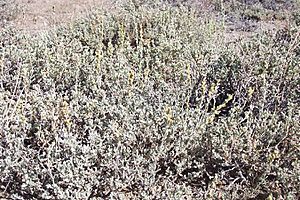Little sagebrush facts for kids
Quick facts for kids Little sagebrush |
|
|---|---|
 |
|
| Scientific classification | |
| Genus: |
Artemisia
|
| Species: |
arbuscula
|
| Synonyms | |
|
|
Artemisia arbuscula is a type of plant called sagebrush. It's found in North America, mostly in the western United States. People often call it little sagebrush, low sagebrush, or black sagebrush. You can find this plant growing in places like Washington, Oregon, California, Colorado, and Wyoming. It likes to grow in open, sunny areas where the soil is dry and rocky, often with a lot of clay.
What it Looks Like
Artemisia arbuscula is a small, gray-green or gray shrub. It usually forms rounded clumps that are about 30 centimeters (about 1 foot) tall. This plant has many branches covered with small, hairy leaves. Each leaf is less than a centimeter long.
The plant's flowers grow in a spike-shaped cluster. These clusters are made up of many small, hairy flower heads. Each head has a few pale yellow disc florets, which are tiny tube-shaped flowers. However, it does not have any ray florets, which are the petal-like flowers you see on a daisy. After the flowers bloom, the plant produces tiny fruits called achenes. These fruits are very small, less than a millimeter wide.
Different Types of Little Sagebrush
Just like there can be different kinds of apples, there are also different types, or subspecies, of Artemisia arbuscula. These are:
- Artemisia arbuscula subsp. arbuscula
- Artemisia arbuscula subsp. longiloba (Osterh.) L.M.Shultz
- Artemisia arbuscula subsp. thermopola Beetle - This type is found in places like Idaho, Utah, and Wyoming.
See also
 In Spanish: Artemisia arbuscula para niños
In Spanish: Artemisia arbuscula para niños

